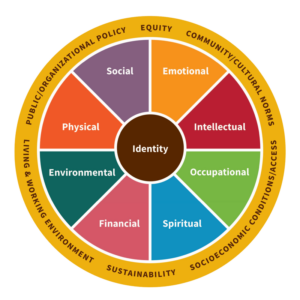Introduction to the Wheel of Well-being

Definition
The Wheel of Well-being is a holistic framework for conceptualizing the diverse components that contribute to optimal health, happiness and life satisfaction. This model encourages individuals to nurture various aspects of personal wellness in balanced ways, leading to greater fulfillment.
Origins
First put forth in a 2003 paper published by Myers, Jane E. Sweeney, Thomas J. Witmer, J. Melvin in 2000, the Wheel of Well-being has its roots in positive psychology and the research-based understanding that wellness encompasses more than physical health alone.
Importance
The Wheel of Well-being identifies seven key areas that promote welfare when strengthened: emotional, physical, social, community, financial, occupational, and spiritual wellness. By self-assessing across those domains, individuals can pinpoint lifestyle aspects needing more attention for overall balance and growth. Just as a bicycle wheel needs properly inflated, interconnected parts to function smoothly, people need engagement across different “spokes” of well-being for smooth life functioning.
The value of this concept is its suggestion that an exclusive focus on singular areas like wealth or fitness is often insufficient for sustainable happiness. Lasting well-being tends to accompany nurturing connections across multiple dimensions including purpose, generosity, security, vocational growth and vitality. Using the Wheel as a template for goal-setting and behavior change empowers more balanced paradigms for health.
Components of the Wheel of Well-being
Physical Well-being
Discuss the role of physical activity, nutrition, and sleep in maintaining overall health. More info about Physical Well-being.
Mental Well-being
Cover the importance of mental health, including stress management, emotional intelligence, and coping mechanisms.
Emotional Well-being
Explain how understanding and managing emotions contribute to resilience and satisfaction.
Social Well-being
Describe the impact of relationships, community involvement, and social support on well-being.
Occupational Well-being
Address the importance of job satisfaction, work-life balance, and career development.
Spiritual Well-being
Touch on the role of values, purpose, and meaning in life, respecting diverse beliefs and practices.
Environmental Well-being
Highlight the influence of one’s physical and environmental conditions on their overall well-being.
Financial Well-being
Note the importance of financial security and financial stress management.
Benefits of Using the Wheel of Well-being
Holistic Approach
The Wheel provides a holistic map of wellness domains that span bodily health to environmental factors. This bird’s eye view of the components of well-being facilitates more integrated approaches to lifestyle changes rather than fragmented optimization of diet alone, for example. People can visualize how nourishing emotional, social, financial and spiritual health also patiently builds comprehensive welfare.
Self-Assessment with Wheel of Well-being
The Wheel allows structured self-reflection for individuals to gauge where they feel they are thriving or struggling around the various spokes like relationships, work-life balance, physical activity and so on. Taking periodic stock of one’s relative strengths and growth areas around financial planning or community engagement, for instance, clarifies priorities for skill development in service of more rounded stability.
Personal Development
Once self-assessment spotlights progress points, the Wheel provides an adaptive scaffold for consciously evolving across wellness dimensions needing attention. People can use the spokes as personal development reminders to expand efforts around nurturing positive coping strategies and stress resilience, for example, or shoring up retirement savings contributions towards security. Having a map for what health encompasses empowers intentional growth.
Practical Applications
Personal Use
On an individual level, people can utilize the Wheel of Well-being to set intentional goals around improving nutrition, building social connections, developing better financial literacy or other dimensions in systemic ways. Tracking lifestyle factors, stress levels, mood and life satisfaction around the various domains over time shows progress. Small, manageable steps towards better self-care, purpose and community bond creation lead to sustainable gains.
Professional Settings
Institutions from corporations to schools to hospitals can integrate assessments and programming based on the Wheel of Well-being model to support staff and customer wellness in a comprehensive fashion. Leadership can examine policies and cultures surrounding things like burnout, recognition programs and access to health services through the lens of holistic welfare to retain talent.
Community Programs
Many local health initiatives already target facets of wellness like heart disease prevention or smoking cessation. Expanding programming through the Wheel of Well-being would encourage things like financial counseling, vocational mentoring or intergenerational service opportunities alongside diet and exercise offerings for enriched community welfare. This paradigm empowers diverse health journeys.
Conclusion and Moving Forward
Encouragement
The Wheel of Well-being presents a meaningful blueprint for expanding narrow definitions of health towards more inclusive horizons. Readers are encouraged through this model to shift perspectives, habits and environments in alignment with fuller thriving. The wheel’s components mutually support each other, together strengthening resolve and contentment. Begin embracing rest, community contribution, financial mindfulness or skill mastery as critical for sustained happiness.
Continuous Improvement
Well-being is not easily won overnight but rather journeys through gradual wheel alignment via insight, diligence and compassion towards oneself over time. Periodically revisiting where your wheel spokes stand provides impetus for realignment whenever life circumstances change or stagnancy sets in. Expect to repeatedly rebalance across the facets of mind, body, purpose and place for smooth riding through life’s curves.
Further Exploration of Wheel of Well-being
Many validated assessments, tools, programs and practices exist to bolster holistic welfare across heartfulness, social connectivity, environmental wellness and other dimensions. Consult professionals in fields aligned with your growth interests for tailored guidance. Books, podcasts, FAQs, and online communities also provide knowledge for those seeking to dive deeper into research and skills supporting multidimensional thriving. Your journey toward greater wholeness and self-actualization continues.




